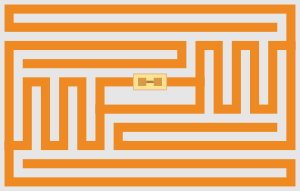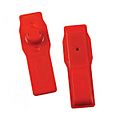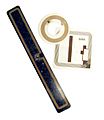RFID facts for kids
Radio-frequency identification (RFID) is a cool technology that uses radio waves to find and track things. Think of it like a special way for objects to "talk" to a computer without needing to be seen directly. It's used for many things, like keeping track of items in a store or timing runners in a race.
RFID isn't meant to completely replace barcodes. Instead, it works alongside them, especially when you need to read codes from a distance. This technology helps identify people, packages, or other items automatically.
It works using two main parts:
- RFID tags: These are small electronic devices. They can be attached to or built into products, animals, or even people.
- RFID readers: These devices send out radio signals. When a tag gets a signal, it sends back its unique information.
Some RFID tags can be read from several meters away, even if the reader can't "see" them directly. Many tags also have regular text or a barcode on them. This helps if the radio part doesn't work, or if you need to read it quickly by eye.
Most RFID tags have two main parts inside:
- An integrated circuit: This tiny computer chip stores information. It also helps send and receive the radio signals.
- An antenna: This part helps the tag pick up signals from the reader and send its own signals back.
There are two main kinds of RFID tags:
- Active RFID tags: These tags have their own battery. This lets them send stronger signals and be read from farther away.
- Passive RFID tags: These tags do not have a battery. They get their power from the radio waves sent by the reader.
Contents
How RFID Is Used
RFID systems are used in many different ways in our daily lives. Here are some examples:
Tracking Goods and Packages
- Logistics: RFID helps companies track packages and parcels as they move around the world. It can be a faster way to track items than using barcodes.
- Road tolls: In some places, RFID tags in cars let drivers pay tolls automatically without stopping.
Security and Access
- Passports: Many countries now put small RFID chips in passports. These chips store your information, making passports more secure.
- Stopping fake products: RFID tags can be used to make sure products, like medicines, are real and not fake.
- Vehicle keys: Many car keys have an RFID tag inside. Only a key with the correct tag can start the car. This makes it much harder for someone to steal a car by copying a key. They can also be used to lock or unlock cars from a distance.
- Identity cards: You might use a contact-less ID card with an RFID chip to get into certain areas, like a school building or a concert. They are also used for ticketing and on public transport cards.
Identifying Animals and People
- Animal tracking: RFID tags are used to identify pets, like cats and dogs, if they get lost. They are also used by scientists to track wild animals, such as turtles, for research.
- Sports timing: In races like marathons, athletes wear small RFID chips. These chips record their exact finish time when they cross the finish line.
- Student attendance: Some schools use RFID tags to quickly mark when students arrive.
Images for kids
See also
 In Spanish: RFID para niños
In Spanish: RFID para niños












